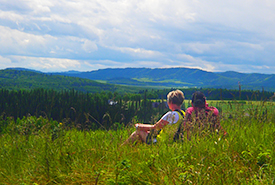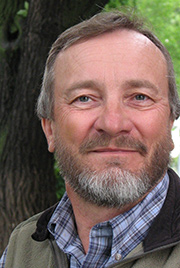The stories we tell (and need to tell) about conservation

Connop Property in Alberta (photo by NCC)
It’s a crisis! A chunk of land of conservation value suddenly comes on the market, or it’s threatened with some form of development or in some way is scarce and connecting habitat for some charismatic megafauna that commands our immediate and urgent attention. An outsider might reflect that our work, the essential work of the Nature Conservancy of Canada (NCC), is done under constant crisis conditions.
But sleeves get rolled up, the ecological reasons for securement are plumbed by NCC staff, the Science and Stewardship Committee ponders the prospect, the Board weighs it and work begins. Phone calls are made, contacts reinvigorated, partnerships formed, asks for money made and made over again, negotiation and deals cut with landowners — all the necessary tasks to secure, for conservation, these vital acres. To provide more urgency we refer to those precious pieces as the last, the best, the only, the rest, the connectors, the space, the sublime and the spectacular.
It is classic understatement to say the work of NCC is important; saving land and wild critters for the public good cannot be anything but. The approach is a blend of technical skills, professional acumen, negotiation and strategic planning. Even though you might think it so, the work is not sentimental. Rather it is pragmatic and focused with a good measure of hard-nosed realism and fiscal restraint.
Yet nothing is more vital to the success of NCC than the stories of conservation, of protecting pieces of the landscape for purposes that are not accounted for with standard business practices. Stories and how they are told are not trivial in the pursuit of raising millions of dollars, of making complex deals with various levels of government and corporations and of getting landowners to the table for discussion about the future of their lands.
We humans are still hard-wired for stories whether we are biologists, ranchers, executives, politicians, bureaucrats or deep-pocketed philanthropists. We make sense of the world and of our lives through stories. Stories form a compass that we navigate by, that we use to articulate our values and how we settle on choices, given many options.
We would do well to reflect on the practicality of storytelling in our conservation work. Why would a landowner choose to seek us out, putting land use restrictions on both their generation and subsequent ones? Why would this donor generously provide the financial backing for land acquisition? Why would a corporation see merit in supporting some of NCC’s work? Why would a politician support policy that smoothes the path to donations for conservation? Because in all cases, doing so sets into motion a story that the action makes possible some article of conservation and that action embodies a strongly held value.
If stories are indeed a vital part and form a role in our conservation work, what kinds of stories do we need to tell about places to save? How should the stories be told to connect and affirm with others? What expansions are necessary in the world of conservation?
We have a history of telling stories of crisis, of a precious place on the brink, with seconds left to save it for the future. There is urgency in these stories, there are compelling reasons for action and there may be a tinge of desperation in the telling. The appeal of crisis stories is to motivate listeners to play a role in changing the narrative, in changing the path and averting an impending tragedy. It is a familiar refrain in the motivation of donors across a broad spectrum.
In its familiarity there is power but there are risks to telling stories of crisis. Our individual lives are not of endless crises piling up, one upon another. A constant refrain of them has the potential of leading to listener exhaustion, of numbness and of disbelief setting in.
A parallel danger in the affected drama of crisis stories is they can convey misleading ideas about conservation work. Ideas like white knights (donors) always sweeping in at the 11th hour, landowners shifting to completely altruistic ends or, most problematically, believing that slow, persistent, patient and quiet negotiation doesn’t work. Most troublesome is the impression that once we avert the crisis, all is well and done.
While a crisis may (or may not) lead to a successful conservation venture, what begins then is a much different story and one NCC needs to tell better, more often and with more vigour. In every case after the paperwork is done and NCC has a piece of the landscape there is the much subtler challenge, with less drama and less publicity of caring for the land, every day, day in, day out, for perpetuity.
Once the drama of dealing with the crisis of securing a piece of valuable habitat is over, the very real temptation is to carry on to the next crisis. We may forget, suspend energy, or neglect the real work of caring for the place we have just finished protecting. We may not think any further investment is necessary.
NCC needs to develop another set of stories — ones beyond narratives of crisis to ones of our role as competent caretakers of lands secured. Sustaining the landscapes secured, maintaining them, often restoring them and managing them with intent and intelligence is a task of equal balance to securing the land in the first place. Perhaps it is an even greater task, with longer timelines, a shift in staff competencies and serious discussion about outcomes.
One thing is abundantly clear: even NCC can not accomplish this stage of stewardship alone. Every NCC property or easement lies bounded within a community. It is the connections within those communities that NCC has forged and needs to continue to forge that will ensure the initial efforts to conserve land stand the test of time. Recognition of community-based stewardship as an essential tool is key, and it requires a different skill set than acquiring land.
NCC needs to “sell” the concept of caring for secured lands with equal vigour to the initial pitches that secured the land. These narratives of caring for, of sustaining the land that we are responsible for provides balance to the usual stories of lands under threat. It would seem obvious that sooner than later donors and supporters will ask, “So, how is that land we helped you secure?” We need to educate people that conservation doesn’t end with a property secured.
Although stories of lands secured are powerful, I think there is equal or greater power (and appeal) in NCC’s continuing role as a steward of lands. IThe challenge is to make it appealing to prospective donors in quieter forms of conservation. In many respects this is a parallel to the invitation to play a role in changing the narrative on the trajectory of a piece of land under threat. Supporting ongoing property management, aiding in improvements in landscape health and monitoring biodiversity responses could be a powerful, nurturing motivator for many people.
This I believe is NCC’s next challenge and task, to work towards a series of stewardship stories. These will have less drama in them but need not be mundane renditions of day to day land management. It is entirely conceivable that people might be riveted by the stewardship task on a property and be able to see the incremental steps towards a property management goal. It could become part of their narrative and a way to see their role in that vital, ongoing and satisfying work.


